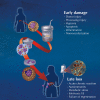Islet transplantation in type 1 diabetes: ongoing challenges, refined procedures, and long-term outcome
- PMID: 23804275
- PMCID: PMC3740705
- DOI: 10.1900/RDS.2012.9.385
Islet transplantation in type 1 diabetes: ongoing challenges, refined procedures, and long-term outcome
Abstract
Remarkable progress has been made in islet transplantation over a span of 40 years. Once just an experimental curiosity in mice, this therapy has moved forward, and can now provide robust therapy for highly selected patients with type 1 diabetes (T1D), refractory to stabilization by other means. This progress could not have occurred without extensive dynamic international collaboration. Currently, 1,085 patients have undergone islet transplantation at 40 international sites since the Edmonton Protocol was reported in 2000 (752 allografts, 333 autografts), according to the Collaborative Islet Transplant Registry. The long-term results of islet transplantation in selected centers now match registry data of pancreas-alone transplantation, with 6 sites reporting five-year insulin independence rates ≥50%. Islet transplantation has been criticized for the use of multiple donor pancreas organs, but progress has also occurred in single-donor success, with 10 sites reporting increased single-donor engraftment. The next wave of innovative clinical trial interventions will address instant blood-mediated inflammatory reaction (IBMIR), apoptosis, and inflammation, and will translate into further marked improvements in single-donor success. Effective control of auto- and alloimmunity is the key to long-term islet function, and high-resolution cellular and antibody-based assays will add considerable precision to this process. Advances in immunosuppression, with new antibody-based targeting of costimulatory blockade and other T-B cellular signaling, will have further profound impact on the safety record of immunotherapy. Clinical trials will move forward shortly to test out new human stem cell derived islets, and in parallel trials will move forward, testing pig islets for compatibility in patients. Induction of immunological tolerance to self-islet antigens and to allografts is a difficult challenge, but potentially within our grasp.
Figures

Similar articles
-
Current status of clinical islet cell transplantation.Methods Mol Biol. 2006;333:47-104. doi: 10.1385/1-59745-049-9:47. Methods Mol Biol. 2006. PMID: 16790847 Review.
-
Islet transplantation in Type-I diabetes: current state and prospects.Ann Acad Med Singap. 1991 Jul;20(4):513-8. Ann Acad Med Singap. 1991. PMID: 1799266 Review.
-
[Research progress on the donor cell sources of pancreatic islet transplantation for treatment of diabetes mellitus].Zhongguo Xiu Fu Chong Jian Wai Ke Za Zhi. 2018 Jan 15;32(1):104-111. doi: 10.7507/1002-1892.201707049. Zhongguo Xiu Fu Chong Jian Wai Ke Za Zhi. 2018. PMID: 29806374 Free PMC article. Review. Chinese.
-
[Islet transplantation in type I diabetes mellitus].Ther Umsch. 2005 Jul;62(7):481-6. doi: 10.1024/0040-5930.62.7.481. Ther Umsch. 2005. PMID: 16075955 Review. German.
-
Advances in pancreatic islet transplantation in humans.Diabetes Obes Metab. 2006 Jan;8(1):15-25. doi: 10.1111/j.1463-1326.2005.00476.x. Diabetes Obes Metab. 2006. PMID: 16367878 Review.
Cited by
-
Interleukin-1 antagonists and other cytokine blockade strategies for type 1 diabetes.Rev Diabet Stud. 2012 Winter;9(4):338-47. doi: 10.1900/RDS.2012.9.338. Epub 2012 Dec 28. Rev Diabet Stud. 2012. PMID: 23804271 Free PMC article. Review.
-
Solid organ transplantation in the 21st century.Ann Transl Med. 2018 Oct;6(20):409. doi: 10.21037/atm.2018.09.68. Ann Transl Med. 2018. PMID: 30498736 Free PMC article. Review.
-
Oxygen environment and islet size are the primary limiting factors of isolated pancreatic islet survival.PLoS One. 2017 Aug 23;12(8):e0183780. doi: 10.1371/journal.pone.0183780. eCollection 2017. PLoS One. 2017. PMID: 28832685 Free PMC article.
-
Oxygen Perfusion (Persufflation) of Human Pancreata Enhances Insulin Secretion and Attenuates Islet Proinflammatory Signaling.Transplantation. 2019 Jan;103(1):160-167. doi: 10.1097/TP.0000000000002400. Transplantation. 2019. PMID: 30095738 Free PMC article.
-
Operational immune tolerance towards transplanted allogeneic pancreatic islets in mice and a non-human primate.Diabetologia. 2019 May;62(5):811-821. doi: 10.1007/s00125-019-4814-4. Epub 2019 Jan 31. Diabetologia. 2019. PMID: 30701283 Free PMC article.
References
-
- Shapiro AM, Rocirdi C. Islet cell transplantation - indications, risks and long-term outcomes. In: Kirk AD, editor. Textbook of organ transplantation. Wiley-Blackwell; 2013. In press.
-
- Shapiro AM, Rocirdi C. The transplant procedure and surgical technique: islet transplantation. In: Kirk AD, editor. Textbook of organ transplantation. Wiley-Blackwell; 2013. In press.
-
- O'Reilly M, O'Sullivan EP, Davenport C, Smith D. "Dead in bed": a tragic complication of type 1 diabetes mellitus. Irish J Med Sci. 2010;179(4):585–587. - PubMed
-
- Koltin D, Daneman D. Dead-in-bed syndrome - a diabetes nightmare. Pediatr Diabetes. 2008;9(5):504–507. - PubMed
-
- Hanas R. Dead-in-bed syndrome in diabetes mellitus and hypoglycaemic unawareness. Lancet. 1997;350(9076):492–493. - PubMed
Publication types
MeSH terms
LinkOut - more resources
Full Text Sources
Other Literature Sources
Medical
